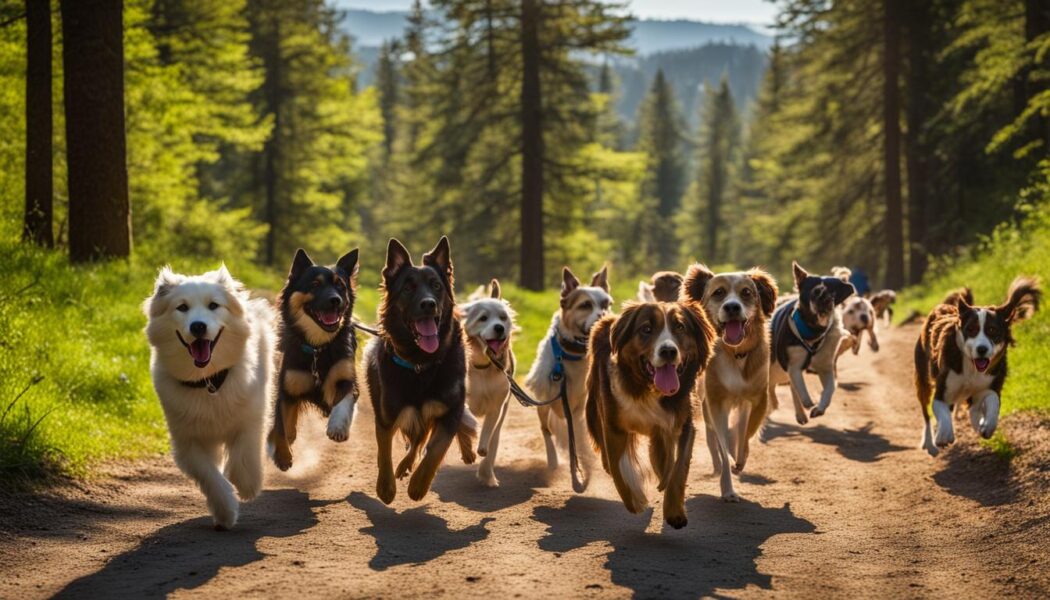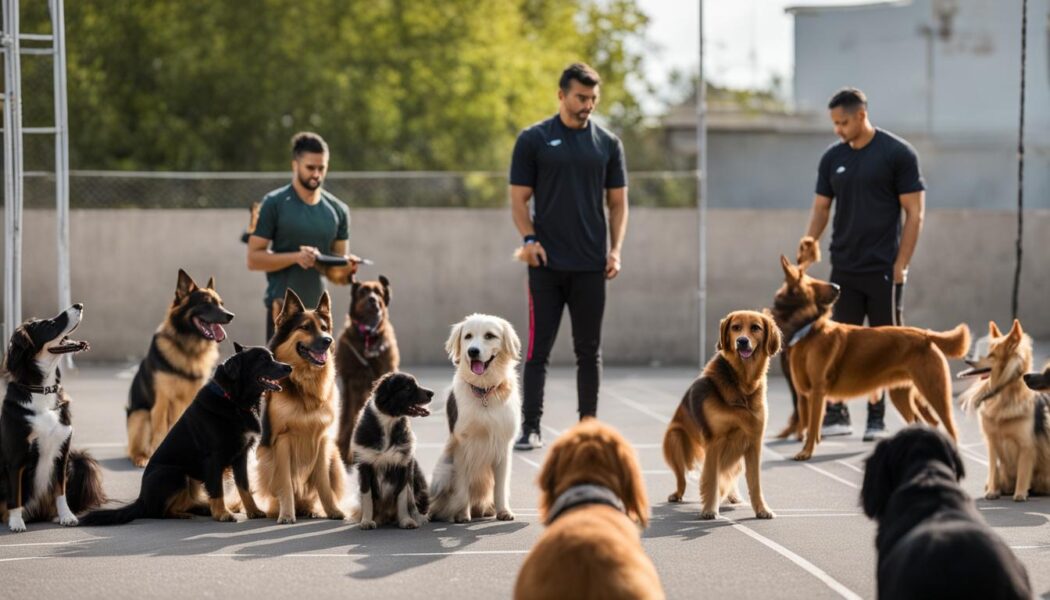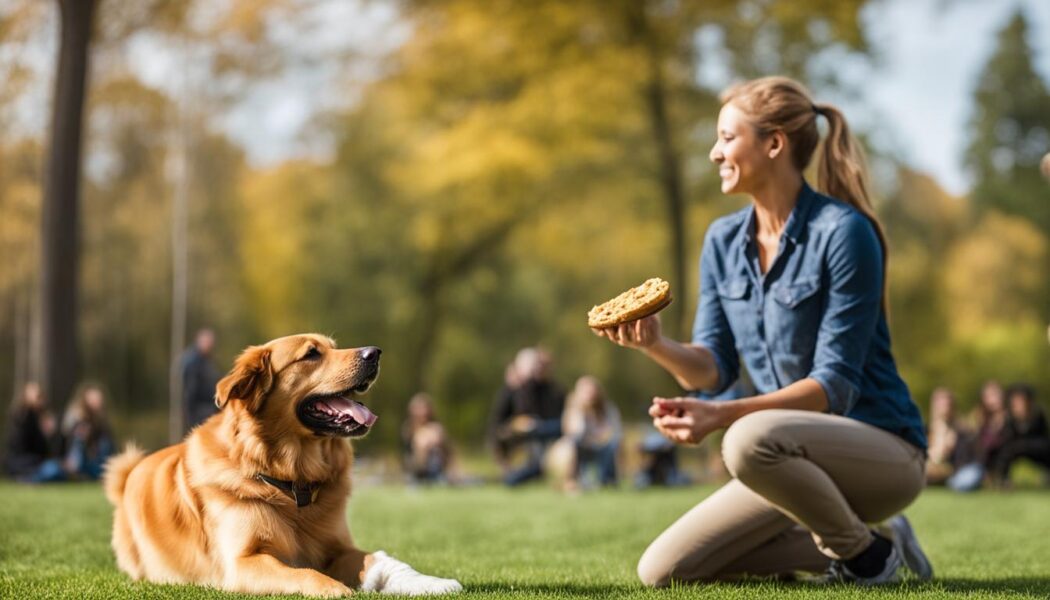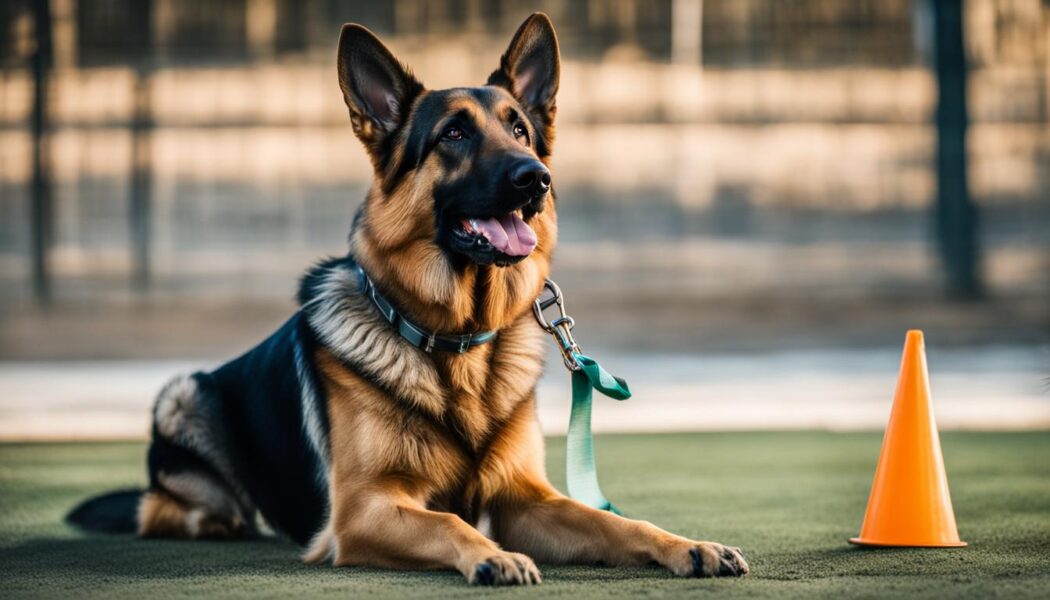As a dog owner, I know that dog obedience training forms the foundation of a strong human-animal bond and helps ensure that our dogs behave appropriately in various situations. Whether you’re starting with puppy training or working to improve your adult dog’s manners, this guide covers essential dog behavior training tips designed to make the process more manageable and enjoyable for both you and your dog.
By consistently implementing a structured training protocol and using positive reinforcement, you’ll be setting your pet up for success and addressing common behavior problems in no time. Beyond teaching manners and tricks, it’s also crucial to remember that socialization plays a vital role in your dog’s development, contributing to their overall well-being and obedience.
Key Takeaways
- Start dog training early to establish a strong foundation of obedience and good behavior
- Focus on core commands like sit, stay, come, and crate training to build a solid foundation
- Utilize positive reinforcement to encourage desired behaviors and make the training experience more enjoyable
- Seek guidance from a professional dog trainer if facing challenges or looking to advance your dog’s skills
- Incorporate socialization into your dog’s training to create a well-adjusted and well-behaved pet
Embarking on the Dog Training Journey
Beginning the dog training journey can be a transformative experience for both pet owners and their canine companions. It is critical to understand the importance of starting a dog obedience program, setting up a foundation for your training efforts, and using positive reinforcement as a prime method. Integrating fun and engaging training sessions, coupled with professional assistance when needed, can ensure your success in establishing a well-behaved furry friend.
Housebreaking and crate training comprise fundamental elements of this journey. Also, teaching your dog to walk properly on a leash early on is vital due to common leash laws and the safety benefits it brings. In this section, we will discuss the primary steps for embarking on successful dog training, from understanding basic principles to seeking professional guidance when necessary.

Basic dog training methods form the foundation of a comprehensive obedience program. To start, focus on creating a consistent schedule for your dog, integrating short and enjoyable training sessions into daily routines. This consistency will minimize frustration and maintain engagement while emphasizing the importance of regular practice.
- Utilize positive reinforcement techniques, such as treats, praise, or toys, to encourage desired behaviors.
- Keep training sessions brief to avoid overwhelming your dog and maintain focus on learning.
- Introduce one command or skill at a time, allowing your dog to master each before moving on to the next.
- Be patient and persistent, understanding that progress may vary depending on individual temperament and previous experiences.
When encountering challenges, don’t hesitate to seek guidance from a professional dog trainer, whether through group classes or private lessons. These experts can offer valuable insights into effective dog training methods and customized solutions tailored to your pet’s specific needs.
Leash training for dogs is a crucial aspect of the overall training journey. Practicing proper leash etiquette ensures that your dog remains safe in public spaces while adhering to common leash laws. Start by introducing your dog to the collar, harness, and leash, gradually progressing to outdoor walks while focusing on maintaining a loose leash and attentive behavior.
| Leash Training Steps | Benefits |
|---|---|
| Introduce collar, harness, and leash | Acclimate your dog to wearing a leash, minimizing resistance or discomfort |
| Practice indoor walks | Familiarize your dog with following your lead in a controlled environment |
| Transition to outdoor walks | Expose your dog to outdoor distractions while maintaining a secure and controlled connection |
| Reinforce loose leash walking | Encourage your dog to walk calmly without pulling, straining, or wrapping around your legs |
| Integrate commands and distractions | Enhance your dog’s focus and responsiveness to commands while navigating various environments |
In conclusion, embarking on the dog training journey involves setting a strong foundation, understanding the value of consistency and patience, and employing effective training techniques. Leash training and foundational obedience are vital components of a well-rounded training program, helping you to establish a harmonious relationship with your canine companion.
The Bedrock of Obedience: Core Commands Every Dog Should Know

The essentials of dog obedience include basic commands such as sit, stay, and heel, which provide structure and help manage dog behavior effectively. These foundational commands are necessary for your dog’s overall training and can be crucial in ensuring safety in various settings. Mastering these simple cues is indispensable, as they underpin more complex training and are integral to a well-behaved pet.
Training Essentials: Sit, Stay, and Heel
Basic dog training involves teaching your dog the fundamentals of obedience, which include the following essential commands:
- Sit: One of the first commands your dog should learn. It helps establish your control and lays the groundwork for more advanced commands.
- Stay: It is crucial for your dog’s safety and is necessary in different situations, such as preventing them from running into the street.
- Heel: This command ensures your dog walks nicely beside you, making walks more pleasant and maintaining control in public settings.
Building from the Basics: Advanced Commands
After acquainting your dog with basic commands, you can proceed to teach advanced commands and tricks for mental stimulation and to further enhance obedience. Tricks can be an exciting way to challenge your dog beyond the basics, fostering a stronger bond between you and your pet. Some advanced commands include:
- Fetch: Teaching your dog to retrieve items for you, offering them physical and mental exercise.
- Roll over: A fun trick that challenges your dog’s coordination and balance.
- Shake: This command teaches your dog to shake hands, making for a charming and friendly interaction with others.
It is essential to remember that training is continuous, and routinely practicing these commands will help your dog remember them.
Creating a Lifelong Training Routine with Your Dog
As training progresses, it should be seen as an ongoing process that continues throughout the life of your dog. Regular training maintains and reinforces learned behaviors, much like how humans retain languages through consistent use.
Keeping a lifelong training routine ensures that your dog remains obedient and responsive in all environments and that the bond and language between you and your dog remain strong.
| Age | Training Focus | Key Points |
|---|---|---|
| Puppyhood (8-16 weeks) | Socialization and Basic Commands | Expose the puppy to various stimuli and experiences, begin teaching basic commands. |
| Young Adulthood (4-12 months) | Reinforcing Basic Commands and Introducing Advanced Commands | Continue practicing basic commands and gradually introduce more complex commands. |
| Adulthood (1-7 years) | Advanced Commands and Routine Reinforcement | Teach advanced commands, maintain a regular training routine with both basic and advanced commands. |
| Senior (7+ years) | Age-Appropriate Training and Sustained Reinforcement | Adjust training based on the dog’s physical abilities and continue regular reinforcement of learned commands. |
The Power of Positive Reinforcement Training

Positive reinforcement training is a proven and effective method for dog training. This approach focuses on rewarding desired behaviors, while ignoring or redirecting undesired ones.
By using various reinforcements, such as treats, toys, or praise, dogs begin to learn expectations and commands in an engaging and pleasurable manner. Positive reinforcement training is not limited to basic commands, but also contributes to mastering advanced commands and behaviors.
Clicker training, a popular tool used in positive reinforcement training, helps achieve fast and effective results. By clearly marking the desirable behavior, the dog begins to associate the click with a reward, and in turn, understands the expected action.
This system allows you to shorten the learning curve and efficiently build on your dog’s obedience foundation.
- Begin by introducing the clicker: Familiarize your dog with the sound of the clicker. Without any specific command, click and reward with a treat immediately. Practice this step multiple times to establish the relationship between the click and the reward.
- Introduce commands: Use the clicker as a tool to reinforce desired actions. As your dog responds to a command, such as “sit,” click the clicker at the precise moment the action is completed, and follow up with a reward. This helps your dog grasp the connection between the click and their response to a command.
- Gradually increase complexity: As your dog becomes comfortable with the clicker system, introduce new commands, increased duration, and various distractions. The ultimate goal is to have a well-behaved dog in any situation and environment.
| Training Method | Benefits |
|---|---|
| Positive Reinforcement Training |
|
| Clicker Training |
|
In conclusion, positive reinforcement training, when combined with clicker training, offers a powerful and rewarding solution for dog obedience training. By utilizing these methods, you and your dog can traverse the journey of lifelong learning and effective communication, resulting in a happy, well-behaved canine companion.
Navigating Common Behavioral Challenges
One of the most essential aspects of dog obedience training is house training, as it addresses the natural inclination of dogs to develop good indoor habits. This includes learning where to go potty, which can prevent accidents inside the home and create a clean environment for both dog and owner.
Let’s dive into the process of house training and discuss how this vital skill can be taught using the right techniques and patience.
House Training: Laying the Groundwork for Good Habits

House training dogs is a crucial part of dog obedience, as it is where they learn the appropriate places to go potty. Whether you have a puppy or an adult dog, starting their training as soon as possible can go a long way in maintaining a clean home and preventing behavioral problems. Here are some tips to help you through the house training process:
- Establish a routine: Consistency is key when it comes to house training. Create a schedule for mealtimes, playtime, and bathroom breaks, and stick to it as closely as possible.
- Utilize crate training: Crate training can be an incredibly helpful tool during house training. The crate provides a designated safe space for your dog, making it less likely for them to have accidents inside the home.
- Choose potty spots wisely: Designate a specific area outdoors, such as a specific tree or grass patch, for your dog to do its business. This consistency makes it easier for your dog to understand where they should go potty.
- Watch for signs*: Dogs often exhibit signs that they need to eliminate, such as sniffing, circling, or whining. Be vigilant when observing your dog and take them outside when these signs are noticed.
- Reward good behavior: Positive reinforcement can work wonders during house training. Praise and reward your dog with a treat when they successfully eliminate outside.
- Persistent patience: House training takes time, so be patient and understand that accidents will happen. Remember to stay calm and continue to reinforce the training techniques and schedule.
Overcoming behavioral challenges like submissive or excitement urination requires an understanding of the possible reasons for this issue, and consistent, compassionate training methods.
The keys to success in house training are persistence, patience, and a consistent approach to teaching your dog the appropriate places to go potty. Mastering house training will set the foundation for good habits, creating a cleaner, more harmonious living situation for both you and your dog.
Integrating Socialization into Your Dog’s Training
Socialization is a vital aspect of obedience training, as it exposes dogs to new people, animals, and environments, reducing their likelihood of developing behavior problems. Efficient socialization leads to more balanced and better-behaved dogs that can handle various situations with ease.
It helps to prevent fear and phobia development, contributing to a dog’s emotional well-being and overall behavior.
Integrating dog socialization into your dog’s behavior training benefits both you and your dog. It aids in the development of communication skills, teaching dogs how to interact politely with their canine peers and appropriately with humans, regardless of their age or environment.
| Socialization Training Components | Description |
|---|---|
| Positive Experiences | Expose your dog to diverse, positive experiences with various people, animals, and environments. |
| Puppy Socialization Classes | Attending structured socialization classes with other puppies can provide a supervised environment for learning positive social interactions. |
| Pet-Friendly Locations | Take your dog to pet-friendly locations, such as dog parks or cafes, to increase their exposure to various situations and stimuli. |
| Meeting New People and Dogs | Regularly introduce your dog to new people and dogs in a controlled and calm manner. |
When prioritizing socialization training, it is crucial to consider your dog’s unique temperament and needs. Keep in mind that every dog is different, and some may require more time and patience in developing their social skills.
Regular, controlled exposure to new people, animals, and environments can promote steady progress in your dog’s socialization training journey.
- Set realistic expectations for your dog’s socialization progress. Some dogs may take longer to adjust to new experiences, and that’s OK.
- Always approach new environments and interactions with a positive attitude, as your dog can sense your emotions and react accordingly.
- Be patient and consistent with your dog’s socialization training, reinforcing good behavior, and providing plenty of praise and rewards.
In conclusion, integrating socialization into your dog’s dog behavior training is a crucial step in creating a well-rounded, well-behaved, and adaptable canine companion. It not only helps prevent fear and phobias but also contributes to a better quality of life for your dog, strengthening the bond between you and your beloved pet.
Conclusion
Embarking on the journey of dog obedience training is crucial to achieving a well-mannered canine, a strong dog-owner bond, and a harmonious living situation. This structured and consistent training approach provides direction, fostering a mutual feeling of love and respect between you and your pet. With patience, practice, and persistence, your dog will transform from unruly to obedient, leading to a healthy, lasting bond with your canine companion.
Socialization forms an essential aspect of obedience training, resulting in more balanced and better-behaved dogs able to handle various situations with ease. This not only prevents fear and phobia development but also contributes to your dog’s emotional well-being and overall behavior.
Remember, the journey of training is constantly evolving as you and your dog grow together, strengthening your relationship built on effective communication and love.
As a dog owner, prioritize investing time in your dog’s training, seek guidance from professional dog trainers and make use of positive reinforcement training methods. Doing so will ensure your dog training success, cultivating a lifetime of reliable, consistent, and enjoyable interactions with your furry friend.
Ultimately, embracing your role as a responsible pet owner,undertaking diligent obedience training, and celebrating your wins along the way creates a lifelong, meaningful dog-owner relationship.
FAQ
When should I start dog obedience training?
It’s essential to start dog obedience training as early as possible, ideally when your dog is still a puppy. However, you can still introduce this type of training to older dogs, although it may require more patience and consistency.
What are the basic commands every dog should know?
The core commands in dog obedience training include sit, stay, come, heel, and crate, which provide structure, help manage dog behavior effectively, and ensure safety in various settings.
How do I use positive reinforcement training?
Positive reinforcement training involves rewarding desired behaviors and ignoring or redirecting undesired ones, using treats, toys, or praise as reinforcement. Tools like clicker training can also be used to enhance this method, achieving fast and effective results in dog training.
What are the benefits of proper socialization for my dog?
Effective socialization helps develop well-adjusted, balanced dogs that can handle various situations with ease. It prevents the development of fear and difficult behavior while promoting their emotional well-being.
How can I address common behavioral challenges, such as house training and submissive urination?
House training and crate training are essential aspects of dog obedience to teach appropriate indoor habits, like where to go potty. As for issues like submissive urination, understanding and consistency in training methodology are necessary. It may also be helpful to consult a professional dog trainer for guidance.
Should dog obedience training be a lifelong commitment?
Yes, training should be an ongoing process that continues throughout the life of your dog. Routine training ensures that your dog remains obedient and responsive in all environments, and it strengthens the bond and understanding between you and your dog.




